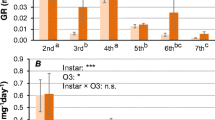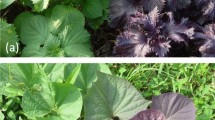Abstract
High mixing ratios of ground-level O3 threaten trophic interactions. In the present study, we conducted laboratory assays, where insect larvae and adults were not directly exposed to O3, to test the feeding behavior and attraction of the coleopteran leaf beetle Agelastica coerulea to early and late leaves of Japanese white birch (Betula platyphylla var. japonica) treated with ambient or elevated O3 levels. We found that overwintered adults were not deterred from grazing elevated O3-treated leaves, but rather preferred them than ambient O3-treated ones. We also found that the feeding behavior of 2nd instar larvae fed on early or late leaves was not influenced by the O3 treatment of the leaves when larvae could choose leaves. These observations of the adults and larvae feeding preferences contradict prior observations in the field conditions where the insects avoided leaves in O3-enriched atmosphere. Since adults preferred elevated O3-exposed leaves in the present laboratory assays, it is worthy of further investigations whether adults change their grazing preference so as to ensure the leaf palatability as a feeding source for their larvae. Hence, new direction towards detailed ovipositional behavior surveys under field conditions is encouraged.



Similar content being viewed by others
References
Agathokleous E, Saitanis CJ, Koike T (2015) Tropospheric O3, the nightmare of wild plants: a review study. J Agric Meteorol 71:142–152
Agathokleous E, Saitanis CJ, Wang X, Watanabe M, Koike T (2016) A review study on past 40 years of research on effects of tropospheric O3 on belowground structure, functioning and processes of trees: a linkage with potential ecological implications. Wat Air Soil Pollut 227:33
Agrell J, Kopper B, McDonald EP, Lindroth RL (2005) CO2 and O3 effects on host plant preferences of the forest tent caterpillar (Malacosoma disstria). Glob Chang Biol 11:588–599
Akimoto H (2003) Global air quality and pollution. Science 302:1716–1719
Barbehenn RV, Constabel CP (2011) Tannins in plant-herbivore interactions. Phytochemistry 72:1551–1565
Bate-Smith EC (1977) Astringent tannins of acer species. Phytochemistry 16:1421–1426
Baur R, Binder S, Benz G (1991) Nonglandular leaf trichomes as short-term inducible defense of the grey alder, Alnus incana (L.), against the chrysomelid beetle, Agelastica alni L. Oecologia 87:219–226
Blande JD, Holopainen JK, Niinemets Ü (2014) Plant volatiles in polluted atmospheres: stress responses and signal degradation. Plant Cell Environ 37:1892–1904
Bolsinger M, Lier ME, Hughes PR (1992) Influence of ozone air pollution on plant-herbivore interactions. Part 2: effects of ozone on feeding preference, growth and consumption rates of monarch butterflies (Danaus plexippus). Environ Pollut 77:31–37
Booker FL, Burkey KO, Jones AM (2012) Re-evaluating the role of ascorbic acid and phenolic glycosides in ozone scavenging in the leaf apoplast of Arabidopsis thaliana L. Plant Cell Environ 35:1456–1466
Box GEP, Cox DR (1964) An analysis of transformations. J R Stat Soc B 26:211–252
Bryant JP, Chapin FS III, Klein DR (1983) Carbon/nutrient balance of boreal plants in relation to vertebrate herbivory. Oikos 40:357–368
Cape JN (2008) Surface ozone concentrations and ecosystem health: past trends and a guide to future projections. Sci Total Environ 400:257–269
Da Rosa Santos AC, Furlan CM (2013) Levels of phenolic compounds in Tibouchina pulchra after fumigation with ozone. Atmos Pollut Res 4:250–256
De Rezende FM, Furlan CM (2009) Anthocyanins and tannins in ozone-fumigated guava trees. Chemosphere 76:1445–1450
Endress AG, Jeffords MR, Case LJ, Smith LM (1991) Ozone induced acceptability of yellow poplar and black cherry to gypsy moth larvae. J Environ Hort 9:221–225
Fares S, Oksanen E, Lännenpää M, Julkunen-Tiitto R, Loreto F (2010) Volatile emissions and phenolic compound concentrations along a vertical profile of Populus nigra leaves exposed to realistic ozone concentrations. Photosynth res 104:61–74
Farré-Armengol G, Peñuelas J, Li T, Yli-Pirilä P, Filella I, Llusia J, Blande JD (2016) Ozone degrades floral scent and reduces pollinator attraction to flowers. New Phytol 209:152–160
Feng Z, Kobayashi K, Ainsworth EA (2008) Impact of elevated ozone concentration on growth, physiology, and yield of wheat (Triticum aestivum L.): a meta-analysis. Glob Chang Biol 14:2696–2708
Freiwald V, Häikiö E, Julkunen-Tiitto R, Holopainen JK, Oksanen E (2008) Elevated ozone modifies the feeding behaviour of the common leaf weevil on hybrid aspen through shifts in developmental, chemical, and structural properties of leaves. Entomol Exp App 128:66–72
Fuentes JD, Roulston TH, Zenker J (2013) Ozone impedes the ability of a herbivore to find its host. Environ Res Let 8:014048
Fuhrer J, Booker F (2003) Ecological issues related to ozone: agricultural issues. Environ Int 29:141–154
Hara H (2015) Leaf beetle (Agelastica coerulea). In: Forest Insect Library of Forestry Research Institute, HRO, http://www.fri.hro.or.jp/zukan/konchu/00data/kochu/hamusi/hannoki/note.html
Hillstrom ML, Lindroth RL (2008) Atmospheric carbon dioxide and ozone alter forest insect abundance and community composition. Ins Cons Div 1:233–241
Hoshika Y, Watanabe M, Inada N, Mao Q, Koike T (2013) Photosynthetic response of early and late leaves of white birch (Betula platyphylla var. japonica) grown under free-air ozone exposure. Environ Pollut 182:242–247
Inoue W, Vanderstock A, Sakikawa T, Nakamura M, Saito H, Shibuya M, Koike T (2016) The interaction between insects and deciduous broadleaved trees under different O3 concentrations and soil fertilities. Boreal For Res 64 (In Japanese)
Jones CG, Coleman JS (1988) Plant stress and insect behavior: cottonwood, ozone and the feeding and oviposition preference of a beetle. Oecologia 76:51–56
Jordan DN, Green TH, Chappelka AH, Lockaby BG, Meldahl RS, Gjerstad DH (1991) Response of total tannins and phenolics in loblolly pine foliage exposed to ozone and acid rain. J Chem Ecol 17:505–513
Julkunen-Tiitto R (1985) Phenolic constituents in the leaves of northern willows: methods for the analysis of certain phenolics. J Agric Food Chem 33:213–217
Kalabokas PD, Cammas J-P, Thouret V, Volz-Thomas A, Boulanger D, Reparis CC (2013) Examination of the atmospheric conditions associated with high and low summer ozone levels in the lower troposphere over the eastern Mediterranean. Atmos Chem Phys Dis 13:2457–2491
Kanoun M, Goulas MJP, Biolley J-P (2001) Effect of a chronic and moderate ozone pollution on the phenolic pattern of bean leaves (Phaseolus vulgaris L. cv Nerina): relations with visible injury and biomass production. Biochem Syst Ecol 29:443–457
Karabourniotis G, Liakopoulos G, Nikolopoulos D, Bresta P, Stavroulaki V, Sumbelle S (2014) “Carbon gain vs. water saving, growth vs. defence”: Two dilemmas with soluble phenolics as a joker. Plant Sci 227:21–27
Koike T (1995) Physiological ecology of the growth characteristics of Japanese mountain birch in Northern Japan: a comparison with Japanese white birch. In: Box E, et al. (eds.) Vegetation Science in Forestry, Elsevier, pp 409–422
Koike T, Tobita H, Shibata T, Matsuki S, Konno K, Kitao M, Yamashita N, Maruyama Y (2006) Defense characteristics of seral deciduous broad-leaved tree seedlings grown under differing levels of CO2 and nitrogen. Popul Ecol 48:23–29
Koike T, Watanabe M, Hoshika Y, Kitao M, Matsumura H, Funada R, Izuta T (2013) Effects of ozone on forest ecosystems in east and Southeast Asia. In: Matyssek R, Clarke N, Cudlin P, Mikkelsen TN, Tuovinen J-P, Wieser G, Paoletti E (eds) Climate change, air pollution and global challenges: understanding and perspectives from forest research. Elsevier, Oxford, pp 371–390
Kopanakis I, Glytsos T, Kouvarakis G, Gerasopoulos E, Mihalopoulos N, Lazaridis M (2016) Variability of ozone in the eastern Mediterranean during a 7-year study. Air Qual Atmos Health 9:461
Li T, Blande JD, Holopainen JK (2016) Atmospheric transformation of plant volatiles disrupts host plant finding. Sci Rep 6:33851
Lindroth RL (2010) Impacts of elevated atmospheric CO2 and O3 on forests: Phytochemistry, trophic interactions, and ecosystem dynamics. J Chem Ecol 36:2–21
Matsuki S, Sano Y, Koike T (2004) Chemical and physical defense in the early and late leaves in three heterophyllous birch species native to northern Japan. Ann Bot 93:141–147
Peltonen PA, Vapaavuori E, Julkunen-Tiitto R (2005) Accumulation of phenolic compounds in birch leaves is changed by elevated carbon dioxide and ozone. Glob Chang Biol 11:1305–1324
Saitanis C, Panagopoulos G, Dasopoulou V, Agathokleous E, Papatheohari Y (2015) Integrated assessment of ambient ozone phytotoxicity in Greece’s Tripolis plateau. J Agric Meteorol 71(2):55–64
Sakikawa T, Oikawa M, Watanabe M, Mao Q, Koike T (2014) The effect of ozone on leaf phenology of white birch (Betula platyphylla var. japonica) grown under free-air ozone exposure. Boreal For Res 62:59–60 (in Japanese)
Sakikawa T, Nakamura M, Watanabe M, Oikawa M, Satoh F, Koike T (2016) Leaf phenology and insect grazing of Japanese white birch saplings grown under free-air ozone exposure. J Agric Meteorol 72:80–84
Schoonhoven LM, Van Loon JJA, Dicke M (2005) Insect-plant biology, 2nd edn. Oxford University Press, New York, p 421
Vanderstock A, Agathokleous E, Inoue W, Eguchi N, Nakamura M, Satoh F, Kanie S, Koike T (2016) Preliminary survey on insect grazing in white birch stands under free-air O3 fumigation. Boreal For Res 64:27–30
Watanabe M, Hoshika Y, Inada N, Wang X, Mao W, Koike T (2013) Photosynthetic traits of Siebold’s beech and oak saplings grown under free air ozone exposure in northern Japan. Environ Pollut 174:50–56
Yamaji K, Julkunen-Tiitto R, Rousi M, Freiwald V, Oksanen E (2003) Ozone exposure over two growing seasons alters root-to-shoot ratio and chemical composition of birch (Betula pendula Roth). Glob Chang Biol 9:1363–1377
Yli-Pirilä P, Copolovici L, Kännaste A, Noe S, Blande JD, Mikkonen S, Klemola T, Pulkkinen J, Virtanen A, Laaksonen A, Joutsensaari J, Niinemets Ü, Holopainen JK (2016) Herbivory by an outbreaking moth increases emissions of biogenic volatiles and leads to enhanced secondary organic aerosol formation capacity. Environ Sci Technol 50:11501–11510
Acknowledgements
The authors are grateful to Dr. Elena Paoletti and Dr. Yasutomo Hoshika of the Institute of Sustainable Plant Protection, Florence, Italy, for kind suggestions. Evgenios Agathokleous is an International Research Fellow (ID No: P17102) of the Japan Society for the Promotion of Science (JSPS).
Author information
Authors and Affiliations
Corresponding authors
Ethics declarations
Funding
This study was funded in part by Grant-in-Aid from JSPS through Type B program (26292075 to T. Koike; 26450188 to M. Nakamura). JSPS is a nonprofit organization.
Conflict of interest
The authors declare that they have no conflict of interest.
Additional information
Responsible editor: Philippe Garrigues
Rights and permissions
About this article
Cite this article
Agathokleous, E., Sakikawa, T., Abu ElEla, S.A. et al. Ozone alters the feeding behavior of the leaf beetle Agelastica coerulea (Coleoptera: Chrysomelidae) into leaves of Japanese white birch (Betula platyphylla var. japonica). Environ Sci Pollut Res 24, 17577–17583 (2017). https://doi.org/10.1007/s11356-017-9369-7
Received:
Accepted:
Published:
Issue Date:
DOI: https://doi.org/10.1007/s11356-017-9369-7




